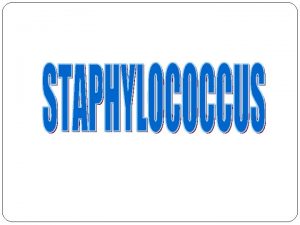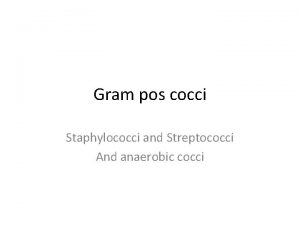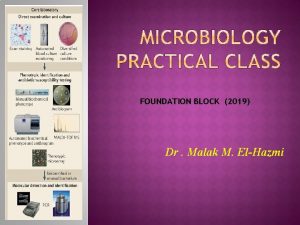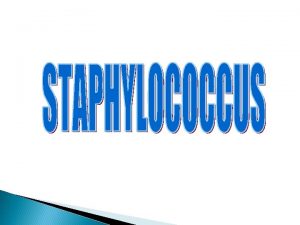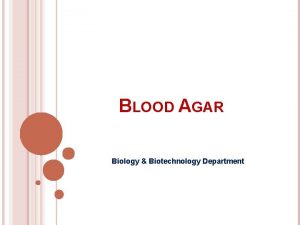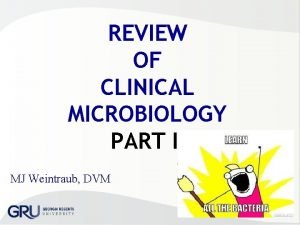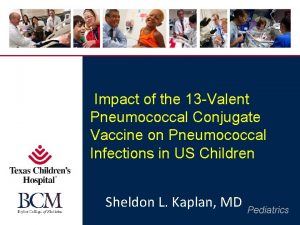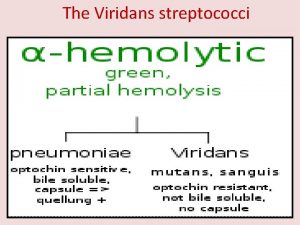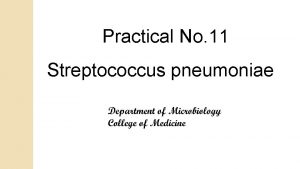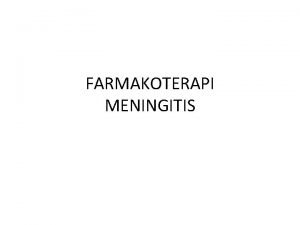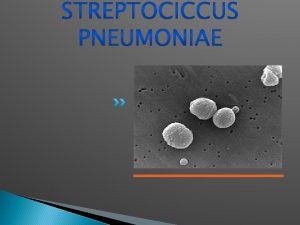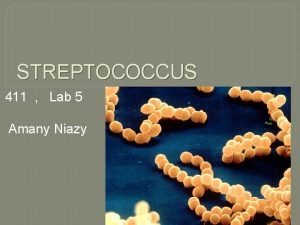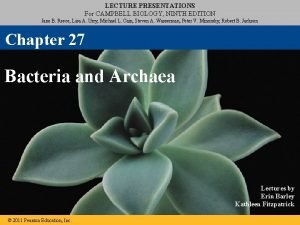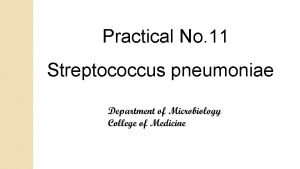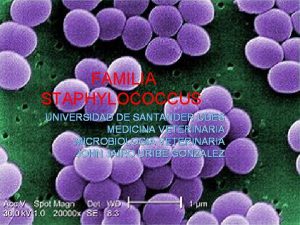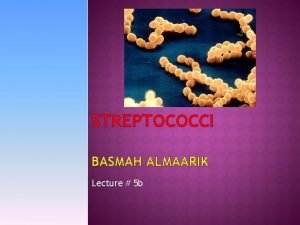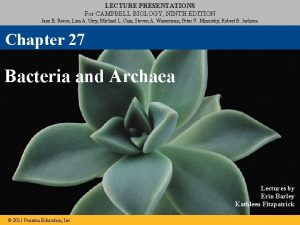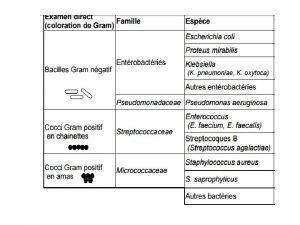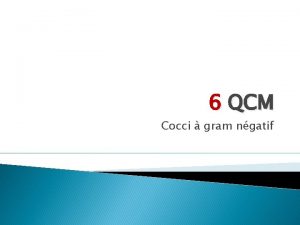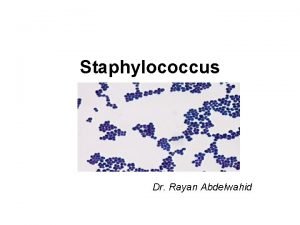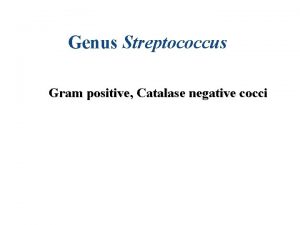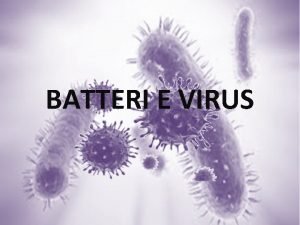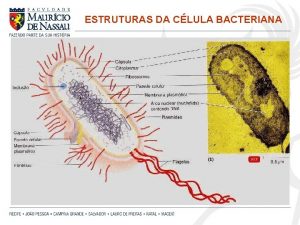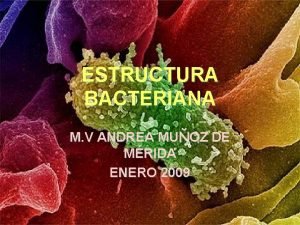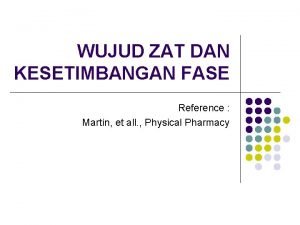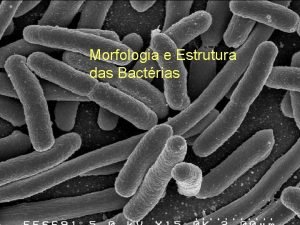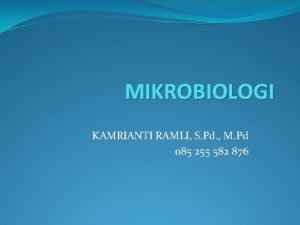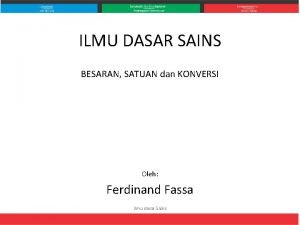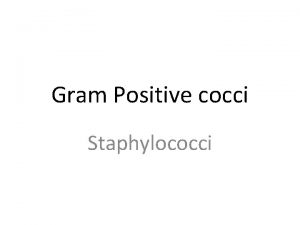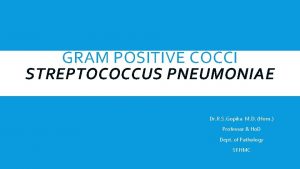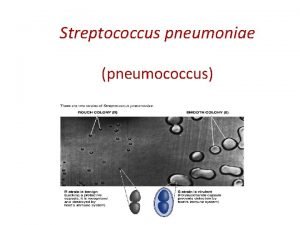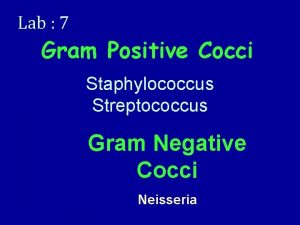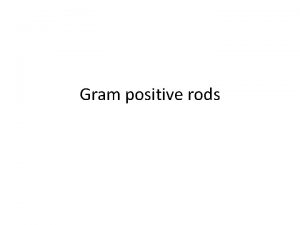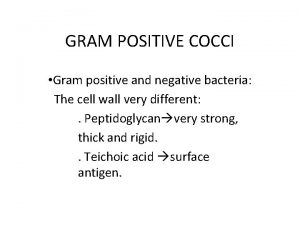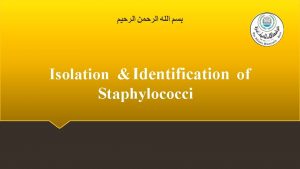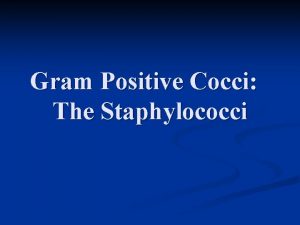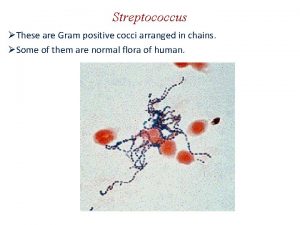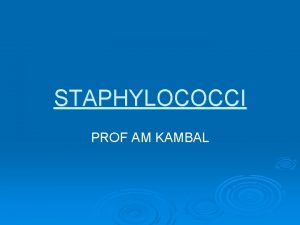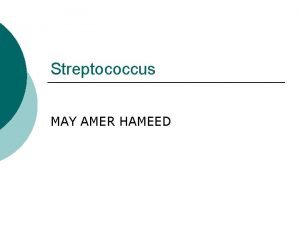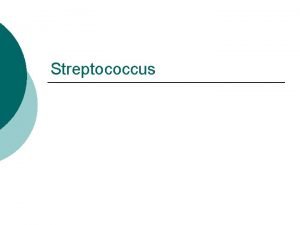Streptococcus pneumoniae Staphylococci Gram positive cocci Lecture 38


































- Slides: 34

Streptococcus pneumoniae Staphylococci (Gram positive cocci) Lecture 38 Faculty: Dr. Alvin Fox 1

KEYWORDS • − − − − • Staphylococcus aureus S. pneumoniae - coagulase (+) diplococci - MRSA (methicillin resistant S. aureus) Pneumococcus - opportunistic diseases autolysin - food poisoning/enterotoxins bile solubility test - toxic shock syndrome/toxic shock toxin optochin susceptibility - exfoliative toxin/scalded skin syndrome capsule - α, β, γ and δ cytotoxins - leucocidin Quellung reaction - lipase Polyvalent vaccine - hyaluronidase - protein A - coagulase (–) - Staphylococcus epidermidis 2 - Staphylococcus saprophyticus

S. pneumoniae 3

S. pneumoniae • leading cause of pneumonia – – – • • • particularly young and old member normal flora, nasopharynx replication and spread after damage to upper respiratory tract (e. g. after the flu) bacteremia meningitis middle ear infections (otitis media) - children 4

S. pneumoniae • α hemolytic • pneumolysin – degrades red blood cells under aerobic conditions • grows well on sheep blood agar • no group antigen 5

Diagnosis - spinal fluid • direct Gram staining • detection of capsular antigen 6

Autolysis – identification after growth autolysin lipoteichoic acid Bile teichoic acid -choline peptidoglycan autolysin Cell membrane 7

C polysaccharide • Teichoic acid (C polysaccharide) – precipitates in serum – binds C-reactive protein 8

Identification optochin resistant optochin sensitive 9

Capsule • prominent – virulent strains • anti-phagocytic • carbohydrate antigens – highly variable among strains – numerous serotypes 10

Capsular vaccine • Immunity – serotype specific – to eradicate the organism in normal flora • Vaccine – a few major serotypes (polyvalent) • Vaccination or the susceptible population – young children – elderly • Immunization – major serotypes susceptible to change – population monitoring essential 11

Quellung reaction • using antisera • capsule "fixed" • visible microscopically 12

Pathogenesis • Teichoic acid – complement activation – large numbers of inflammatory cells at infection site 13

Therapy • S. pneumoniae – most strains susceptible to penicillin – resistance is common 14

STAPHYLOCOCCI • • • Gram positive Facultative anaerobes Grape like-clusters Catalase positive Major components of normal flora - skin - nares 15

Staphylococcus aureus 16

One of commonest opportunistic infections, both hospital and community acquired: acquired • pneumonia • osteomyelitis • septic arthritis • bacteremia • endocarditis • abscesses/boils • other skin infections 17

Antibiotic therapy • Resistance to penicillin – penicillinase • Resistance to methicillin ‾ modified penicillin binding protein ‾ methicillin resistant S. aureus (MRSA) • Vancomycin • current drug of choice • resistance observed but uncommon at this time 18

Hospital infection control • MRSA now such a problem – monitoring by PCR of nasal swabs – eradication • antibiotics • whole body antisepsis 19

Food poisoning • not an infection • food contaminated by humans – growth of bacteria – production of enterotoxin • onset and recovery both occur within few hours 20

Food poisoning • • Vomiting nausea diarrhea abdominal pain 21

Toxic shock syndrome. 22

Toxic shock syndrome • fever • rash • desquamation • vomiting • diarrhea 23

Toxic shock syndrome • Toxic shock toxin - Dissemination • Organism – no dissemination 24

S. aureus • babies – scalded skin syndrome • exfoliatin 25

Lytic exotoxins: • • α toxin β toxin (sphingomyelinase C) γ toxin δ toxins – detergent-like • leucocidins 26

Protein A inhibits phagocytosis Fc receptor immunoglobulin PHAGOCYTE Protein A BACTERIUM 27

Spread • tissue-degrading enzymes – lipase – hyaluronidase 28

Identification • Sheep blood agar – β hemolytic – yellow pigmented (aureus) • mannitol fermentation • coagulase-positive • phage-typing, rarely performed 29

Staphylococcus epidermidis • major member, skin flora • opportunistic infection - less common than S. aureus • nosomial infections - shunts, catheters • artificial heart valves/joints 30

Identification • Sheep blood agar – non-hemolytic – Non-pigmented • Does not ferment mannitol • Coagulase negative 31

Several other coagulase negative staphylococcal species • common on human skin • some species cause opportunistic infection 32

Staphylococcus saprophyticus • urinary tract infections • this coagulase-negative species (and others) – not usually differentiated from S. epidermidis 33

Summary Figure (Identification Scheme) Note: S. viridans is ALPHA hemolytic and negative for all the tests below GRAM POSITIVE COCCI Catalase + Staphylococcus (Clusters) Coagulase + S. aureus Beta hemolytic mannitol yellow - S. epidermidis Non-hemolytic mannitol white - Streptococcus (pairs & chains) Hemolysis/Test BETA: Bacitracin + S. pyogenes (group A) CAMP/ Hippurate + S. agalactiae (group B) ALPHA: Optochin /Bile Solubility + S. pneumoniae GAMMA OR ALPHA: Bile Esculin + 6. 5% Na. Cl Enterococcus + Bile Esculin + 6. 5% Na. Cl Group D Non-Enterococcus Group D - 34
 Mannitol fermentation
Mannitol fermentation Gram positive cocci
Gram positive cocci Gram positive cocci
Gram positive cocci Erythrogenic toxin
Erythrogenic toxin Gram positive cocci in urethral discharge
Gram positive cocci in urethral discharge Gram positive cocci
Gram positive cocci Streptococcus pneumoniae alpha or beta hemolysis
Streptococcus pneumoniae alpha or beta hemolysis Kvlb agar
Kvlb agar Pediatr infect dis j
Pediatr infect dis j Quellung reaction
Quellung reaction Inulin fermentation test streptococcus pneumoniae
Inulin fermentation test streptococcus pneumoniae Streptococcus pneumoniae
Streptococcus pneumoniae Patgeno
Patgeno Bile solubility test
Bile solubility test Korarchaeotes
Korarchaeotes Inulin fermentation test streptococcus pneumoniae
Inulin fermentation test streptococcus pneumoniae Cocos en racimos
Cocos en racimos Plasmidos
Plasmidos Asm microbelibrary
Asm microbelibrary Korarchaeotes
Korarchaeotes Cocci gram positif en amas
Cocci gram positif en amas Example of gram negative cocci
Example of gram negative cocci Qcm cocci gram positif
Qcm cocci gram positif Staphylococci
Staphylococci Streptococcus gram negative
Streptococcus gram negative Eubatteri
Eubatteri Lofotríquio
Lofotríquio Flagelo
Flagelo 20 gram fenol dicampur dengan 30 gram air
20 gram fenol dicampur dengan 30 gram air Tekanan uap larutan
Tekanan uap larutan Morfologia das bacterias gram positivas e gram negativas
Morfologia das bacterias gram positivas e gram negativas Mole-mole stoichiometry
Mole-mole stoichiometry Perbedaan bakteri gram positif dan negatif
Perbedaan bakteri gram positif dan negatif Diagram 3 fase
Diagram 3 fase 1ons berapa gram
1ons berapa gram

